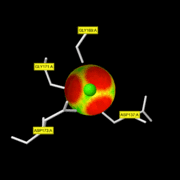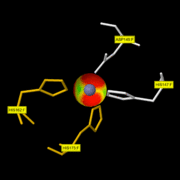Sandbox Reserved 1125
From Proteopedia
(Difference between revisions)
| Line 38: | Line 38: | ||
The zinc-binding motif HEXGHXXGXXH presents in the catalytic domain is characteristic for the protease activity of MMP-8. | The zinc-binding motif HEXGHXXGXXH presents in the catalytic domain is characteristic for the protease activity of MMP-8. | ||
===== Zn999 : the catalytic zinc ===== | ===== Zn999 : the catalytic zinc ===== | ||
| - | It is involved in the catalytic activity. In a publication [http://www.ncbi.nlm.nih.gov/pmc/articles/PMC394940/?page=2] which studies the catalytic domain of MMP8 thanks to the Pro-Leu-Gly-hydroxylamine inhibitor, this ion is penta-coordinated with: His197, His201 and His207 of MMP8 and with the carbonyl and the hydroxyl oxygen of the hydroxamic acid moiety of the inhibitor. On this <scene name='71/719866/Zn999_interactions/2'>link</scene> you can only see the 3 His of MMP8 with the Zn999. | + | It is involved in the catalytic activity. In a publication [http://www.ncbi.nlm.nih.gov/pmc/articles/PMC394940/?page=2] which studies the catalytic domain of MMP8 thanks to the Pro-Leu-Gly-hydroxylamine inhibitor, this ion is penta-coordinated with: His197, His201 and His207 of MMP8 and with the carbonyl and the hydroxyl oxygen of the hydroxamic acid moiety of the inhibitor. On this <scene name='71/719866/Zn999_interactions/2'>link</scene> you can only see the 3 His of MMP8 with the Zn999. The fourth ligand of the catalytic zinc is a water molecule. |
[[Image:ZN pocket interaction.gif | thumb|ZN pocket interaction]] | [[Image:ZN pocket interaction.gif | thumb|ZN pocket interaction]] | ||
===== Zn998 : the structural zinc ===== | ===== Zn998 : the structural zinc ===== | ||
| Line 66: | Line 66: | ||
== Mechanism == | == Mechanism == | ||
| - | To express collagenolytic activity, | + | To express collagenolytic activity, MMP-8 needs to have both the catalytic and hemopexin domains but it is not clear how the hemopexin domain help to cleave triple-helical collagens because it does not bind to collagen.<ref>PMID:8489511</ref> |
| - | + | To allow cleavage of the individual alpha chains of collagen, the binding of collagenases must partially unwind triple helix by inducing a conformational change in alpha chain. However, the molecular basis of this mechanism is not known.<ref>PMID:6270090</ref> | |
| - | + | The peptide lies antiparallel to the edge strand IV by forming a number of hydrogen bonds. | |
| - | < | + | |
| + | |||
Cleavage at Gly775–Ile776 or Leu776. <ref>PMID:9094424</ref> | Cleavage at Gly775–Ile776 or Leu776. <ref>PMID:9094424</ref> | ||
Revision as of 17:24, 28 January 2016
MMP8
MMP-8, also called, Neutrophil collagenase or Collagenase 2, is a zinc-dependent and calcium-dependent enzyme. It belongs to the matrix metalloproteinase (MMP) family which is involved in the breakdown of extracellular matrix in embryonic development, reproduction, and tissue remodeling, as well as in disease processes, such as arthritis and metastasis. The gene coding this family is localized on the chromosome 11 of Homo sapiens .[1]
| |||||||||||
References
- ↑ "MMP8 matrix metallopeptidase 8 (neutrophil collagenase)"
- ↑ Stams T, Spurlino JC, Smith DL, Wahl RC, Ho TF, Qoronfleh MW, Banks TM, Rubin B. Structure of human neutrophil collagenase reveals large S1' specificity pocket. Nat Struct Biol. 1994 Feb;1(2):119-23. PMID:7656015
- ↑ 3.0 3.1 Substrate specificity of MMPs
- ↑ Hirose T, Patterson C, Pourmotabbed T, Mainardi CL, Hasty KA. Structure-function relationship of human neutrophil collagenase: identification of regions responsible for substrate specificity and general proteinase activity. Proc Natl Acad Sci U S A. 1993 Apr 1;90(7):2569-73. PMID:8464863
- ↑ Knauper V, Osthues A, DeClerck YA, Langley KE, Blaser J, Tschesche H. Fragmentation of human polymorphonuclear-leucocyte collagenase. Biochem J. 1993 May 1;291 ( Pt 3):847-54. PMID:8489511
- ↑ Welgus HG, Jeffrey JJ, Eisen AZ. Human skin fibroblast collagenase. Assessment of activation energy and deuterium isotope effect with collagenous substrates. J Biol Chem. 1981 Sep 25;256(18):9516-21. PMID:6270090
- ↑ Knauper V, Docherty AJ, Smith B, Tschesche H, Murphy G. Analysis of the contribution of the hinge region of human neutrophil collagenase (HNC, MMP-8) to stability and collagenolytic activity by alanine scanning mutagenesis. FEBS Lett. 1997 Mar 17;405(1):60-4. PMID:9094424
- ↑ "Neutrophil collagenase"
- ↑ "Metalloendopeptidase activity"
- ↑ "Extra Binding Region Induced by Non-Zinc Chelating Inhibitors into the S1′ Subsite of Matrix Metalloproteinase 8"
- ↑ Balbin M, Fueyo A, Knauper V, Pendas AM, Lopez JM, Jimenez MG, Murphy G, Lopez-Otin C. Collagenase 2 (MMP-8) expression in murine tissue-remodeling processes. Analysis of its potential role in postpartum involution of the uterus. J Biol Chem. 1998 Sep 11;273(37):23959-68. PMID:9727011
RESSOURCE : Image:2oy4 mm1.pdb ( la structure du monomère )


